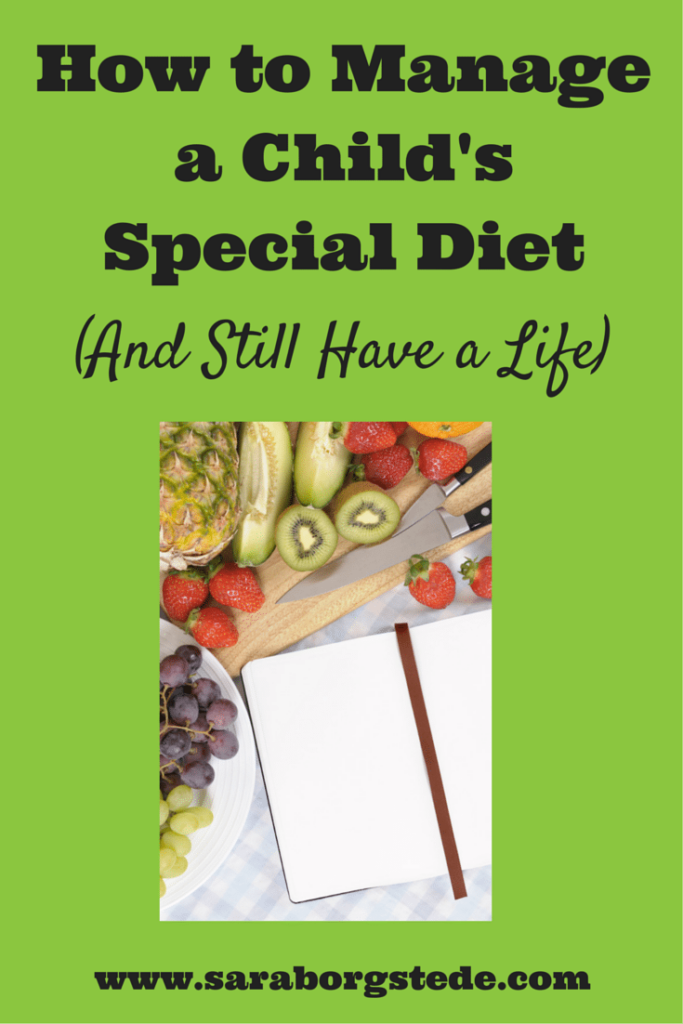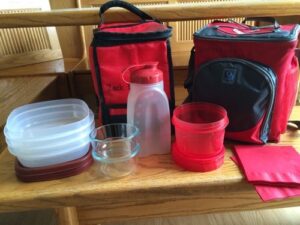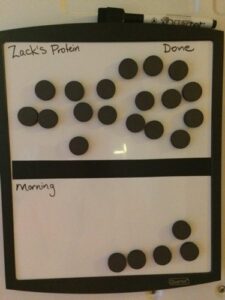
When our son Zack was one year old, he was diagnosed with a life-threatening rare genetic metabolic condition. Part of the treatment for the condition is a highly specialized low-protein diet. A low-protein diet is almost the total opposite from the way most of America eats. It requires him drinking formula for life, along with weighing and measuring food, purchasing food from a medical supply company, and cooking with special flours and ingredients. When it comes to special diets, this is the big time, my friends.
My husband also has a peanut and soy allergy, so I understand those restrictions, too. Please note that my son Zack’s condition is metabolic and not an allergy, so he does not have an anaphylactic reaction if he eats restricted foods. If you are dealing with a child with severe food allergies, of course consult with your doctor, and check out this blog too with ideas for managing everyday life. The tips below will still apply.
If your child is on a special diet, you have my heart-felt understanding. It’s tough, isn’t it? If this a new diagnosis, allow me to lead you through what has been helpful for me. My son is now six years old and WE ARE LIVING TO TELL ABOUT IT. You will, too! Even if you are a pro at maintaining a special diet for a child or yourself, perhaps you will learn some new helpful ideas below.
How to Manage Your Child’s Special Diet
- Breathe. This will NOT rule your life or your child’s. Make the choice right now that this diagnosis will not rule your life. This is perhaps the toughest step of all. When my son was first diagnosed, my thoughts went crazy. “What about birthday parties? Can we never go out for an ice cream cone again?” Our metabolic dietitian made the comment, “After all, it’s just food,” at one point, and I thought she was totally nuts. I learned to put this into perspective with time, and you will, too. However, for awhile you will feel like this is going to take over your life, and that is okay. It’s all part of the learning process. Just cling to the hope it won’t last forever.
- Choose a color for all your child’s items. We chose red for Zack. Zack’s cups are red. His lunch bag is red. His food containers are red or have red lids. We use these Rubbermaid containers and these Pyrex ones. This way when we reach into the fridge, we can quickly grab his items. At school, he and his teachers know his items are in the red containers. I purchased red napkins to put his snacks on, too.

Zack’s red gear.
- We use Inchbug labels for Zack’s milk cups. You can specialize these rubber labels with your child’s name and other information, and they can go right into the dishwasher with the cup. Inchbug also has allergy alert labels. You can get pre-made ones or customize. (We love these cups, by the way, by Contigo. After trying EVERY cup possible, these are great because they are spill-proof but they have a button and not a straw. Straws are a pain.)
- Zack wears a medic alert bracelet. This is an ongoing yearly membership so if there is an emergency, the first responders can call and receive all his medical information. We can call them or go to the website and update Zack’s information anytime. Zack currently has the paracord bracelet which is very sturdy. Before that, we had the kids’ sports band but the rubber end kept breaking off, so I wouldn’t recommend that one. If you think your child will pull off a bracelet, order it for the ankle. We did that with Zack the first couple years of his life and that worked well. I recommend ordering a couple because if you are like us, one is going to go missing at any given point, and then it will show up a few weeks later. This is worth the expense.

Zack’s medic alert bracelet — paracord.
- Get organized. Depending on the diagnosis, you might need to keep food logs, learn a cooking system, or research recipes. Everyone is different for what works for them. Don’t go crazy with this because it’s going to evolve as you learn. I tend to dive into everything 110%, and then learn I didn’t need to do everything so crazy. Start with a file on your computer or a 3-ring binder. Pinterest is a great place to research recipes. There is information there for EVERY type of diet.
- Plan to spend some money. It stinks, doesn’t it? A special diet is going to cost more and be harder to make taste as good. There is just no way around it. So, carve some money out in your budget somehow. Your little person is worth it. You might also find you are spending a crazy amount at the health food store all of the sudden but not eating out as much, so it might not be as expensive as you originally thought. Many people find their whole family eats in a more healthy way when one person is on a specific diet, too.
- Freezer cook in bulk. If you’ve always been a fly-by-the-seat-of-your-pants type of meal planner, this is going to be a change. You’ll need to do some planning ahead for your child with a special diet. If you’re going to make a special pizza, it just makes sense to make 2, cut them up into individual pieces, and freeze them. Then you have 12-14 servings of pizza on hand for anytime your family wants pizza. Wrapped correctly, it keeps well. We wrap them in saran wrap, then in a small ziplock bag, then all the small ziplocks in a large ziplock. Both the small ziplock and the large are labeled with Zack’s name, the food type and the protein amount. A few special meals like this will go a long way to supplement meals your child can have along with the family.
- Plan to carry food with you. Depending on how specialized the diet, you’ll be carrying food with you when out and about. Just get used to this, and it’s not such a big deal. We use an insulated lunch sack. We keep Zack’s emergency medical information, a small travel food scale, and an outfit change in an outside pocket. Inside we carry his special milk and a snack or meal.
- Birthday parties and other special events can be managed. I thought my son was doomed to not enjoy birthday parties and other special events like other kids his age, but everything has been manageable, even with his high level of dietary restrictions. If the other kids are having cupcakes, I bring one of his low-protein ones. He eats the fruits and veggies that are available. Ice cream is more challenging but if it’s a location I can bring some, I bring some sorbet he can have. There are alternatives to most foods. The truth is that most of the time Zack is excited about the event and usually doesn’t care. I care about it so much more than he does!
- Create a school safety plan. I worked together with the school nurse to create a school safety plan for Zack’s special diet. School districts vary in how medical issues are handled, but your school should offer something similar. We created a plan for lunch supervision, special classroom events, and what to do in case of emergency and illness. Our school has been fantastic about partnering with us. Check out this post about partnering with your school.
- Educate loved ones gently. I know it’s terribly frustrating when people we love just don’t get it. No, we want to scream, this is NOT like your cousin’s aunt’s friend’s sister’s kid who couldn’t drink milk. Or, YES, tortillas have gluten in them. Please don’t feel them to my child! I understand your ongoing frustrations. But try to remember your loved ones don’t live and breath these issues day-in-and-day-out the way we do. We were just as naive a few weeks/months/years ago. Educate, and then continue to supervise.
Take heart! While a special diet is a challenge, you can still have a life! You are doing your child a wonderful act of love, not only by caring for his or her special diet, but by showing that this challenge will not totally sideline your whole family. Facing adversity is a part of life for all of us.
The example we set will be so important for our kids for years to come. Great job, mom and dad!
Do you have a child with a special diet? What tips have you found to be helpful? List them in the comments below.
Update, September, 2015: We have started using this very simple magnet system to help Zack track his own protein counts for the day. We bought round magnets and a magnetic dry erase board (divided in half with a piece of duct tape). Zack starts with 23 magnets in the morning — one for each gram of protein in the morning. As he eats a food item, he moves the pieces up. It looks like this:









Great post! I have 2 year old with dairy and soy allergy. My 5 year old is better at catching foods than many other family members. The part about getting extended family to understand has been the hardest. Some think if you give just a little he will out grow. Not the case for him right now. We are lucky that it’s not so bad to the point we are going to the ER but one little slip leads too nausea, cramps, and a few sleepless nights. You do need to be organized. I find more planned grocery store trips are needed cuz not every store has what I need.
Thanks for sharing, Kat. It’s so true that the siblings end up being a fantastic help! Our oldest daughter learned so loved to cook and is now in culinary school, in large part due to helping me with Zack’s diet. (She has written a number of guest posts on this website.) So you never know where there will be hidden blessings in all of this. 🙂 You are right, also, that it requires more grocery store trips. I’ve found that to be true as well.
I have an 11 year old son who was diagnosed with food allergies when he was 1, and another son who is on a special diet, having been diagnosed with ulcerative colitis last summer. These are great tips. With two special diets now, I am finding I need to get better organized, like you mentioned, and you have encouraged me to do more “make ahead and freeze.” All the best to your son!